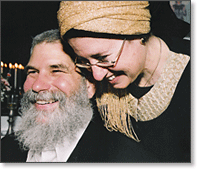Of all the mitzvot, rituals and customs of Rosh Hashanah,
blowing the shofar stands out as the most potent of all its symbols. The
physical action of blowing the shofar entails breathing deeply in and then
blowing out. This action is reminiscent of the description of the formation of
man in Genesis: “and God blew into his nostrils the soul of life” (Genesis
2:7). It is explained in Kabbalah and Chassidic thought that God blowing into
man the soul of life mirrors in an allegorical manner the way a person first
gathers air into his lungs from the diaphragm, the deepest recesses of his inside,
in order to after words blow out fully. It is thus understood that the soul of
man emanates, as it were, from the deepest essence of God. This idea is an
essential foundation of Chassidism and is expressed in the teaching that the
soul of man is “a portion of God Above” (paraphrased from Job 31:2 as taught in
the second chapter of Tanya). When Rosh Hashanah is called in the prayers the
“birthday of the world,” it means the creation of the physical universe in
general, but more specifically, the anniversary of the creation of man. In this
light we can understand the blowing of the shofar on Rosh Hashanah as the
remembrance of God blowing into man the soul of life.
While the physical action of
blowing the shofar is from inside-out, the action most associated with Yom
Kippur is just the opposite - from the outside-in. Throughout the night and day
of the Yom Kippur fast we continually take our clenched fist and tap our
hearts, hoping to arouse repentance and remorse for our actions. The prayers of
Rosh Hashanah begin the ten day period of repentance in a general fashion,
while the prayers of Yom Kippur hone in on the details. The thoughts, speech
and actions of the previous year, all of which began within us and moved
outside us to affect the world around us, are all brought back inside, to be
reviewed, rectified and atoned for.
The holiday of Succot, following
the contemplative days of Rosh Hashanah and Yom Kippur are in essence a
continuation of the same repentive process, but with a special emphasis on joy
and integration. What begins on Rosh Hashanah as ethereal and idealistic
longings and promises of the heart must now be actualized and brought into
practical reality. Shaking the four species (palm, citron, myrtle and willow)
represents the integration of the inside-out action of Rosh Hashanah with the
outside-in action of Yom Kippur. This is accomplished by shaking the four
species to the six directions of space, by first holding them close to
the heart and then shaking outwards, followed by bringing them back to the
heart. All the most inner, deep felt prayers of the previous holidays born in
the heart and mind must now find practical ways to manifest themselves in the
outside world. The in-out, out-in, motion of shaking the four species is a potent
symbol of unification and actualizing our goals and hopes for the new year.
The integration which takes place
during Succot is further represented by circling the synagogue once each day of
Succot and then seven times on the seventh and last day of Succot called
Hoshanah Rabbah. The holiday cycle, now drawing to a culmination, is
symbolized by these seven circuits of the synagogue. Some Chassidim have
the beautiful custom of blowing the shofar after each circuit, in order
to emphasize the entire process beginning on Rosh HaShanah is now coming to a
close. Just as the Jews marched around Jericho
seven times and then blew the shofar, causing the walls to come down, this is
our chance to break down any last psychological walls still standing between us
and God.
An element of Yom Kippur is added
to Hoshanah Rabbah by those who have the custom to wear their special holiday
robe, a kittel, as they did on Yom Kippur. Though we usually think of
Neila, the last prayer of Yom Kippur as representing the “closing of the gates”
of the ten day period of repentance and atonement, we are taught that the final
seal is actually on Hoshanah Rabbah. This is symbolized by hitting five willow
branches on the ground five times, reminiscent of the hitting of the heart on
Yom Kippur. Additionally, many of the prayers and the way they are chanted
during the ten days of repentance are repeated on this day. Hoshanah Rabbah
thus takes many of the elements of Rosh HaShanah, Yom Kippur and Succot and
weaves them inside-out and outside-in.
Whereas during Succot we
shake the four species and make one circle of the synagogue daily, on Simchat
Torah we “shake” ourselves by dancing joyously with the Torah scrolls. The
dancing of this day is the true integration of all the previous holidays and
their various inner and outer actions and symbols. The constant circling brings
us to a place where inside-out and outside-in weave together in perfect harmony
and unity. As we finish the Torah on this day we immediately roll it back to
the very beginning and start again - the epitome of the statement in the Sefer
Yetzira - “Their end is enwedged in their beginning and their beginning in
the end.”

No comments:
Post a Comment